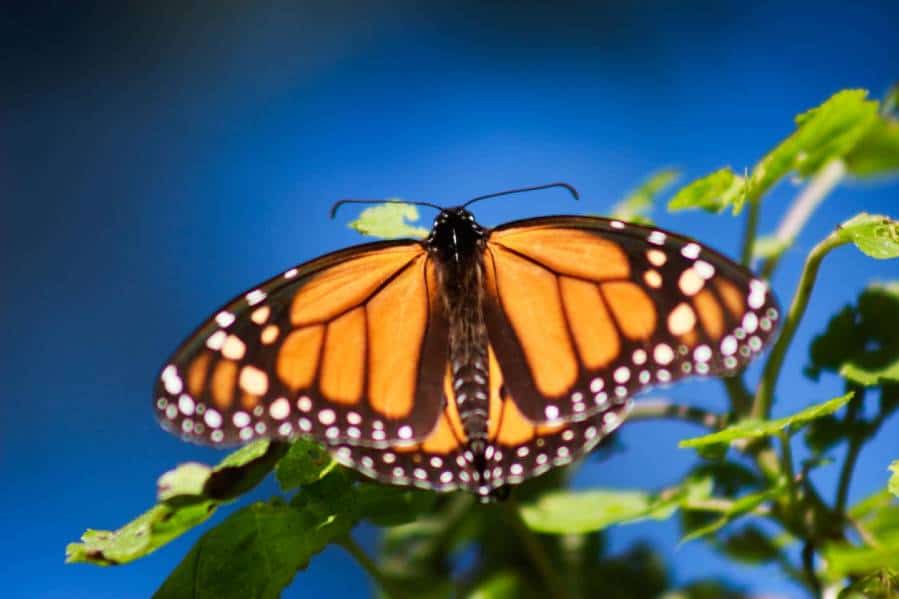Simon Fraser University researchers are playing a key role in guiding conservation efforts to protect a declining butterfly population. The eastern monarch butterfly, an important pollinating species known for its distinct yellow-orange and black colour, is diminishing due to the loss of the milkweed plant—its primary food source.
Researchers analyzed current conservation strategies and recommended changes to how and where declining milkweed can be restored, based on assessments of climate and butterfly migration. Their study is published today in Frontiers in Environmental Science.
SFU PhD student Rodrigo Solis-Sosa and professor Sean Cox, from the School of Resource and Environmental Management, led the study with biological sciences professor Arne Mooers. The trio collaborated with Christina Semeniuk, Great Lakes Institute for Environmental Research (GLIER) and study co-writer Maxim Larrivée, director of the Insectarium de Montréal, one of the five Montréal’s Space for Life museums.
Solis-Sosa says researchers hope to prevent the eastern monarch butterfly from the same fate as the western population, which typically migrated from the Okanagan to California each winter. This year’s measurements of western monarch butterfly colonies found “zero overwintering populations, putting them at an all-time low and closer to extinction,” he explains.
Eastern monarch butterflies overwinter in Mexico from November to March then migrate and reproduce across the U.S. before reaching eastern Canada in late August.
Milkweed has declined across the U.S. due to clearing land for agricultural use, GMO crops, herbicides and climate change. While identifying the U.S. midwest as the best place to focus on restoration efforts, given optimal weather and milkweed availability when the monarch butterfly arrives, the team also found that the southern U.S. has a paramount yet somewhat neglected role.
“While increasing the number of milkweed stems in the South wasn’t as effective as in the Midwest, decreasing their number in the South was catastrophic,” says Solis-Sosa. “While the South may not play a huge role in increasing the eastern monarch butterfly population, it acts as a safety net.”
Researchers also found that recommended estimates of between 1.2 and 1.6 billion milkweed stems falls short of supporting butterfly populations— by 50 to 90 percent. Existing conservation models don’t factor in the effects of drought, changes in temperature and the stem’s effective usability by the monarch butterflies.
“Monarchs may need at least three billion stems to reach a safe minimum threshold population of six overwintering hectares,” says Solis-Sosa. The population once covered the equivalent of 18 hectares over its wintering territory nearly 25 years ago, but that hasn’t risen above six over the past decade. The latest measure has dwindled to just 2.3 overwintering hectares.
Communities in Mexico also depend on monarch butterfly ecotourism as an essential part of their livelihoods. “Monarch butterflies also hold a special significance in traditional Mexican culture,” says Solis-Sosa. “They arrive in Mexico by November 2—the Day of the Dead—and symbolize the dead souls of loved ones arriving to comfort them through the dark and cold winter season. Losing the monarch butterfly would represent a cultural loss to the Mexican people.”
Solis-Sosa says their research will help policymakers across North America update conservation strategies and has already led to discussions with the Commission for Environmental Cooperation (CEC). The CEC supports cooperation between North American Free Trade Agreement (NAFTA) partners to address environmental issues of continental concern.
AVAILABLE SFU EXPERT
RODRIGO SOLIS-SOSA, PhD candidate, School of Resource and Environmental Management
[email protected]
CONTACT
CHANTAL CÔTÉ, Communications Officer, Montréal Space for Life
[email protected]
MELISSA SHAW, SFU Communications & Marketing
236.880.3297 | [email protected]
Simon Fraser University
Communications & Marketing | SFU Media Experts Directory
778.782.3210


